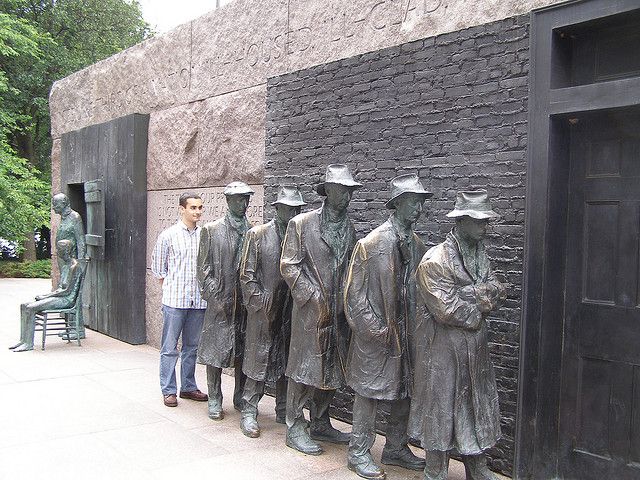Timothy Noah, at Slate, has been writing an excellent, in-depth series of articles on the ever-rising income inequality here in the United States. Among his more disturbing finds are that income inequality is higher now than it was preceding the 1929 crash. Income inequality is not good for an economy, we know that, but it is also potentially damaging to democracy. This three decades-long trend of economic stratification, which has been dubbed The Great Divergence by Paul Krugman, has economists, political scientists, and Timothy Noah understandably concerned. Timothy Noah looks at the problem through many different lenses, trying to isolate the most important factors (I was upset to find out that I can’t just blame Ronald Reagan; conservatives might be upset to learn that illegal immigrants aren’t to blame), and makes the picture quite complicated. What is interesting about the series of articles, at least to us here at Urban Nation, is the correlation between income inequality and trends in urbanization, which seems well-worth examining.
Noah starts us off in 1915, the first time a scholar did any study of income inequality. Willford King, a statistician at the University of Wisconsin, found that the top 1% of Americans took in about 15% of the country’s net worth, a troublingly high number, still lower than today’s 24%. After the Great Depression, the war effort, redistributive policies like the G.I. Bill, and American dominance in manufacturing, the 50’s and 60’s were a great era for income equality. Economists, according to Noah, call it the Great Compression; highest and lowest incomes had never been so close together, nor would they in the future. Urbanists will note that the 50’s and 60’s also saw the rise of mass-produced suburbia. This era, writes Noah, was probably the best time to be middle-class, white, and Christian in America. On a manufacturing job salary, you could be the only breadwinner in your household, and still own a home and send your children to college.
The flip-side to the suburban expansion, and increase in quality of life was, of course, the abandonment of so many cities all across the country, many scarred by the same highways that helped bleed them dry. So, in this creation of the so-called American Dream, we also created the inverse — a veritable nightmare — in the South Bronx, East Baltimore, North Philadelphia, and so many other neighborhoods across the country. It’s no news that capitalism is a zero sum game, but this process was particularly brutal. It was also subsidized by federal level policy decisions. When people think of redistributive wealth policies in the Postwar years, they likely think of Great Society programs, but it was actually the subsidization of suburbia that coincided with the Great Compression of the 50’s and 60’s, and redistributed wealth more effectively, actually helping whole classes of people attain prosperity considered previously unattainable. Again, so long as you were white.
If greater income equality meant larger inequalities between city and suburb down the road, what does our current economic inequality mean for the places we live? What about ten years from now? If a 1960’s Cape Cod ranch house and a 1970’s bombed-out skeleton of a building in the Bronx are the dual symbols of the Great Compression’s urban problem, then what will the equivalent be for us, here at the precipice of the Great Divergence? What places best represent the income inequality that has developed over the last few decades? Put in another way, to what extent is the way we build places these days symptomatic of this societal sickness we’ve been suffering the last three decades?
Is it places like WIlliamsburg, Brooklyn? The source of endless scorn and envy in New York? In case you’ve been living under a rock: the waterfront on the North Side of Williamsburg was once a major center of industry in New York, but was eventually emptied out as industry moved away, or simply went out of business. As artsy types got priced out of Manhattan, many flocked to the old warehouses, converting them into lofts; Bloomberg eventually grandfathered many into legality with his massive 2005 re-zone of Northern Brooklyn. In essence, a new neighborhood had been made out of something previously uninhabitable, and abandoned by industry. But Williamsburg’s gentrification was so rapid and so thorough that there’s something that seems special about it, reflective of larger trends in our economy, or society. New Yorkers tend to think about the problems of New York as starting and ending in New York, but isn’t it more likely that gentrification is getting rapider and rapider in New York because of macroeconomic shifts in our economy? Shifts that funnel more and more students to New York after graduation instead of to — I don’t know — Akron, Ohio, as David Brooks suggested in his latest column. Has this shift trucked so many professionals into New York that tremendous wealth is now built directly atop entrenched poverty? Or is this nothing new in New York, just further-flung than usual?
To see the flip-side of this trend, look to where union labor and manufacturing used to exist: Detroit, Youngstown, Cleveland, etc. These cities, instead of tearing down old buildings to put up condominiums, are tearing down old buildings to prevent blight, and to relieve city services of their duties in the face of a constantly declining tax base. Is Detroit’s abandonment the inverse of Williamsburg’s gentrification? In richer cities, the inequality is put side-by-side, in an uncomfortable, loathsome way; for cities left in the dust of deindustrialization, the inequality is presents as existing between cities, not within them. Gone is the city/suburb divide between rich and poor, income inequality manifests itself within wealthy cities and between cities.
You may notice that this sounds similar to what Richard Florida has been writing about for some time: spatial fixes, the creative economy, etc. But, by bringing rising income inequality — and its causes — into the picture, we can see that it’s not Detroit’s fault that it has been abandoned, and Detroit’s fix is not in Detroit’s hands, as Florida might argue; also we can see that the Creative Class revitalization of neighborhoods leaves many people out of the fun. These problems are structural, not matters of consumer choice, or on the other hand, chamber of commerce savvy.
In fact, perhaps it is this very shift to a “creative class” economy, so celebrated by Florida, that explains the destruction of the middle class, and this massive divergence in incomes. Either way, it’s an interesting new lens to look at two very important urban trends in the past few decades: gentrification and abandonment. If federal policy is to blame for this divergence, then they are also, in a sense, responsible for what is happening in the Midwest as well as North Brooklyn. It’s worth thinking about.





_600_350_80_s_c1.jpg)










